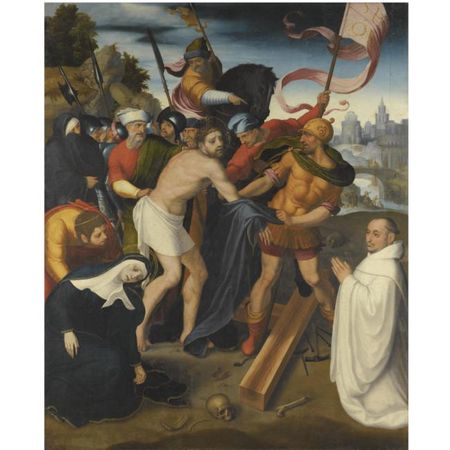Juan Correa de Vivar (Mascaraque, circa 1510 - 1566 Toledo), Christ on the road to calvary
Juan Correa de Vivar (Mascaraque, circa 1510 - 1566 Toledo), Christ on the road to calvary
oil on panel. 154.5 by 125 cm.; 61 by 49 1/4 in. Estimate 60,000—80,000 GBP - Lot Sold 193,250 GBP
PROVENANCE: Probably commissioned by the convent of San Martín de Valdeiglesias, near Toledo, in the 1550s;
Duc d'Alcedo, Biarritz;
Acquired by a descendant of the present owner in Biarritz circa 1918.
NOTE: This exceptional panel was painted by Juan Correa de Vivar in the early 1550s, and was probably commissioned by the Cistercian convent of San Martín de Valdeiglesias, in the diocese of Toledo. It is an excellent example of both Correa's mature style and, more generally, the Mannerist tradition prevalent in Spain in the middle of the century, of which Correa himself was one of the leading exponents, along with the Valencian trio Joan de Joanes, Fernando Yañez and Fernando Llanos.
From circa 1545 Correa de Vivar worked extensively for the Monasterio de San Martín de Valdeiglesias near Toledo, and for about five years he appears to have worked almost exclusively for them, there being only three other small commissions recorded in the years 1546-50; the altarpiece for the church of Santiago del Arrabal de Toledo; another for the church of Herrera el Duque in Badajoz, and another for the church of San Nicolás in Toledo. While the series of commissions from San Martín are not recorded, the lack of documented works by Correa de Vivar during the period 1546-50 would argue for a dating of the San Martín panels to this time, an idea lent further support by their stylistic proximity to the retablos of the convent of Guisando, which Antonio Ponz and, later, Chandler Post believed to have been executed in the middle of the 1540s, and Mateo Gomez slightly earlier. It is probable, given its proximity to Guisando, that the San Martín commissions were made as a direct result of the success of the Guisando commission. Compared to other known works of this date, Dr. Isabel Mateo Gomez has pointed to a distinct stylistic similarity of the present work with Correa's masterpiece, the Death of the Virgin in the Prado, which she dates to the end of the 1540s.1 Dr. Gomez also believes this latter to have been painted for the Monasterio de San Martín, a proposal which, for both works, is endorsed by the presence of a donor of the Cistercian order of Saint Bernard.
When, as part of his Viaje de España2 Antonio Ponz visited the monastery in 1773, many of Correa's works, as well as those of other artists, had already been dispersed amongst neighbouring convents, like the Oratorio de Santa Catalina (he does not record the presence of the present painting but nor does he of the majority of the works now thought to have been there). Zabaleta's 1836 inventory of the monastery is even less help given the monumental dispersal of ecclesiastical collections that took place in the late 18th and early 19th century due to the French Revolution, the looting of Napoleonic troops and, most importantly, the so-called Desamortización in which the state ordered the sale or dispersal amongst museums of ecclesiastical and noble art collections. Furthermore, during the 19th century the vast majority of paintings in Spain that were sold were sent to Paris for sale due to the profusion of auction houses there and their ability to attract greater numbers of moneyed buyers. It is likely that the present work left Spain, and possibly the monastery of San Martín, for France at this turbulent time (possibly with the Duc d'Alcedo who seems to have moved from Spain to Biarritz circa 1900), resurfacing in 1918 in Biarritz where it was acquired by a descendant of the present owner.
We are grateful to Dr. Isabel Mateo Gómez for endorsing the attribution to Juan Correa de Vivar on the basis of photographs and for her help in cataloguing this work.
1. I. Mateo Gómez, Juan Correa de Vivar, Madrid 1983, pp. 65-6, reproduced plate XXXII.
2. A. Ponz, Viaje de España, republished Madrid 1947.
Sotheby's. Old Master Paintings. 03 Dec 08. London courtesy Sotheby's. www.sothebys.com

/https%3A%2F%2Fprofilepics.canalblog.com%2Fprofilepics%2F1%2F0%2F100183.jpg)
/https%3A%2F%2Fstorage.canalblog.com%2F03%2F02%2F119589%2F96711876_o.jpg)
/https%3A%2F%2Fstorage.canalblog.com%2F11%2F31%2F119589%2F94773502_o.jpg)
/https%3A%2F%2Fstorage.canalblog.com%2F20%2F83%2F119589%2F94772815_o.jpg)
/https%3A%2F%2Fstorage.canalblog.com%2F26%2F72%2F119589%2F75604929_o.jpg)
/https%3A%2F%2Fstorage.canalblog.com%2F59%2F60%2F119589%2F26458628_o.jpg)



/http%3A%2F%2Fstorage.canalblog.com%2F83%2F70%2F119589%2F118921890_o.jpeg)
/http%3A%2F%2Fstorage.canalblog.com%2F23%2F85%2F119589%2F94371110_o.jpg)
/http%3A%2F%2Fstorage.canalblog.com%2F31%2F88%2F119589%2F93128593_o.jpg)
/http%3A%2F%2Fstorage.canalblog.com%2F66%2F09%2F119589%2F91773363_o.jpg)